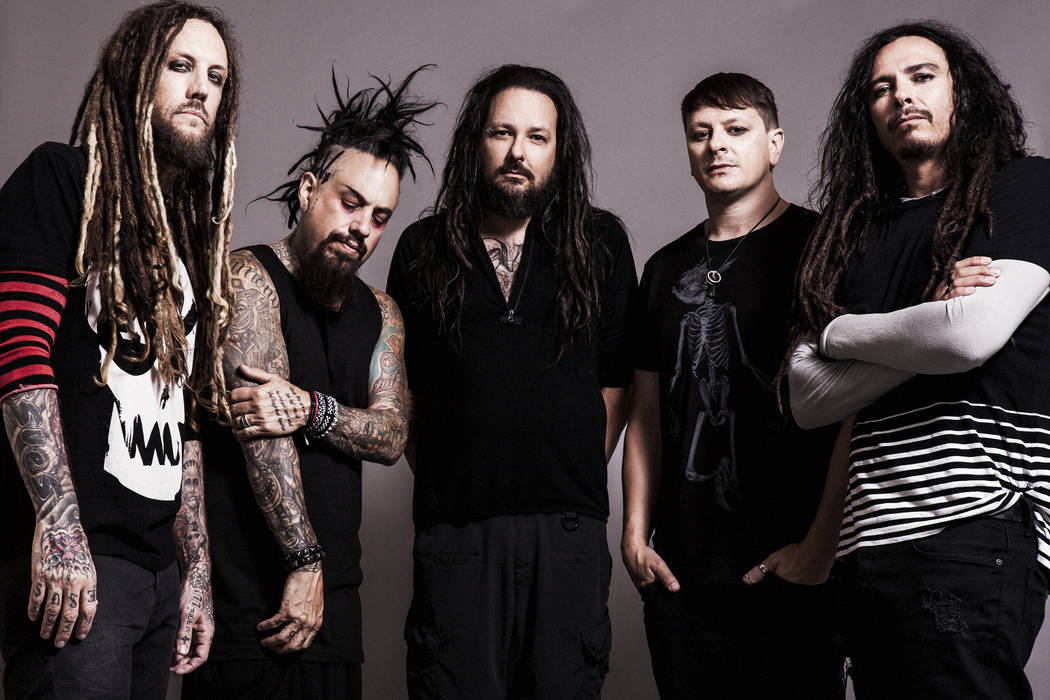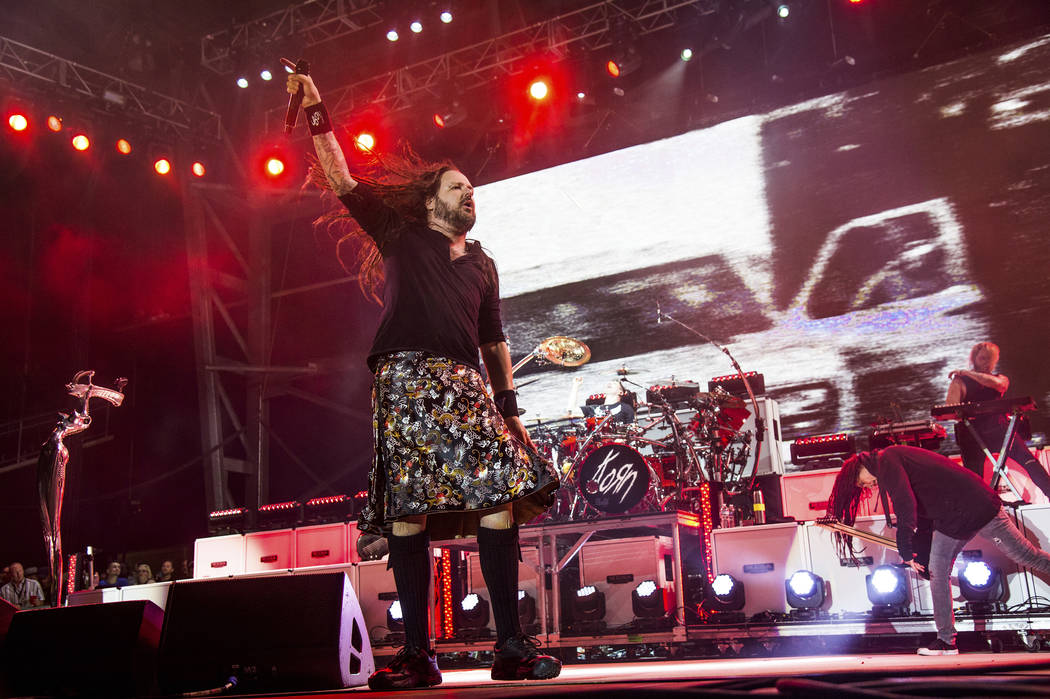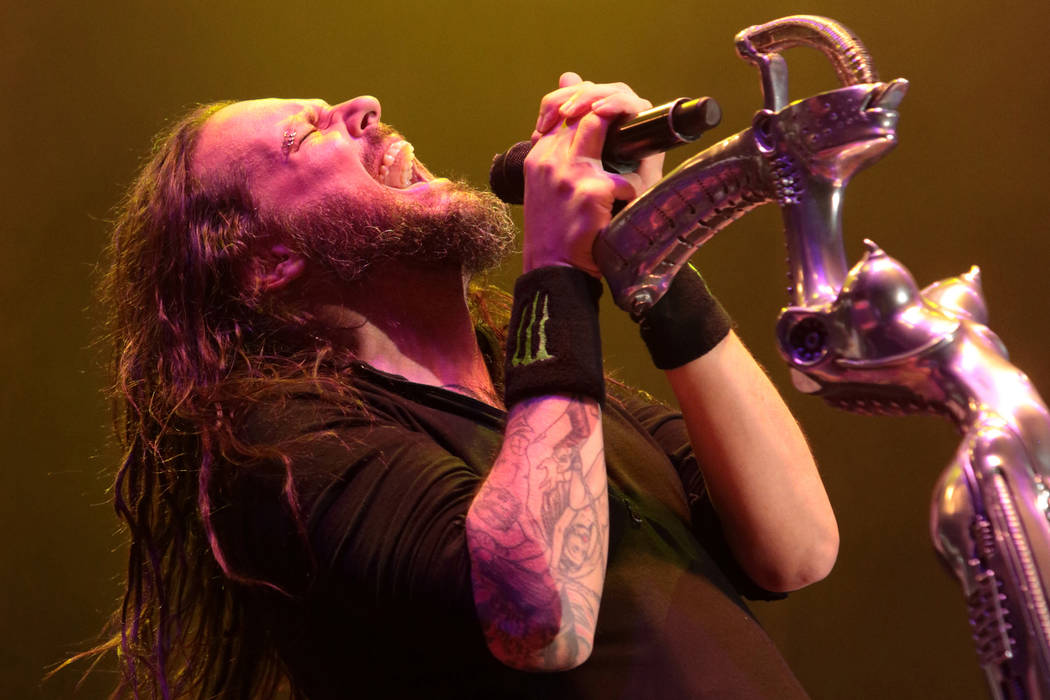Korn celebrates influential album with special Las Vegas show
The mid-’90s were hard on heavy metal — as hard as heavy metal is on the nerves of parental units.
After the “Cowboys From Hell” in Pantera scored a shocking No. 1 on the Billboard Top 200 album chart with the bracing “Far Beyond Driven” in the spring of ’94, only Metallica reached that perch, with “Load” and “Reload,” in the ensuing years, and the latter act was obviously well-established by that point.
Then Korn’s “Follow the Leader” was released on Aug. 18, 1998.
The album debuted atop the charts with 268,000 copies sold, officially ushering in the nü metal boom years.
With Korn taking the hip-hop-influenced sound to new commercial heights via the group’s third record, a ton of acts would follow: Kid Rock’s “Devil Without a Cause,” released on the same day as “Leader,” would sell more than 11 million copies. Korn disciples Limp Bizkit dropped their second album, “Significant Other,” the following summer, moving 16 million units worldwide.
Heavy music infiltrated the mainstream like it hadn’t in years — and hasn’t since — with bands such as Sevendust, Coal Chamber, Soulfly, Papa Roach, Linkin Park, Disturbed and others going gold and platinum.
Sure, some might argue that catalyzing the nü metal scene is an achievement akin to pioneering a new strain of herpes — there was Crazy Town, after all — but that scene also begat greats such as Deftones, System of a Down and Slipknot, among the dwindling few heavy bands who can still fill large halls and arenas.
Compare that era to this one, when only a smattering of hard-edged bands have broken into the mainstream in the past 20 years.
Nü metal on the charts was better than no metal on the charts.
So how did Korn do it?
With the band celebrating the 20th anniversary of its top-selling album with a trio of special one-off shows in Vegas, Los Angeles and San Francisco, let’s take a look back and see.
They expanded metal’s emotional range
It wasn’t that long ago that a headbanger was allowed to shed a tear only when the free clinic ran out of penicillin.
Metal was practically defined by a mucho-macho masculinity that could feel a little stifling, not to mention more than a little off-putting to the opposite sex.
But Korn helped change that.
It began on the band’s self-titled 1994 debut, where frontman Jonathan Davis actually breaks down in tears during album closer “Daddy,” which recalls his childhood abuse. Elsewhere on that record, he acknowledges being bullied as a kid and how it felt to be branded a weakling growing up, expressing a vulnerability seldom heard in heavy metal.
All this emotional rawness would come to a head on “Leader,” where Davis publicly struggled with severe mental health issues as he wrangled with his burgeoning stardom on songs such as smash hit “Freak on a Leash” and “Seed.”
“Like some (expletive) freak, I’m so pressured, I’m so weak,” Davis vents on the latter song, feeling trapped by his growing fame.
Sure, we know, crocodile tears for the millionaire metal dude. Think that lifestyle is hard? Try roofing houses for a living in Vegas.
But the larger point here is that at a time when Davis and company were becoming larger-than-life rock stars, the Korn frontman was, in many ways, deflating his own status by expressing an emotional fragility that can be hard for anyone to talk about when not reclined on a therapist’s couch.
He reaffirmed a message that “The Big Lebowski” taught us in 1998: Strong men also cry. (Wipes tear). Strong men also cry.
That’s not all Korn accomplished on “Leader.”
They made metal cool
Once upon time, there was but one thing scarcer at metal shows than unicorn-adorned clothing items: girls.
Take no offense, female headbangers: You are a strong, proud breed, even if your numbers were few at one point.
Now, of course, there were always plenty of ladies at, you know, Warrant gigs back in the day — or maybe we’re thinking of the performers on stage; it was hard to tell the difference between the two, to be honest — but hair metal was metal in name only, so we’re not counting that crowd.
When Korn hit, though, all this began to change, big time. Women started coming to shows in droves.
There were numerous reasons for this: They were a groove-heavy band that registered in the hips, and there was a libidinous side to them lyrically, a dark sensuality in places that resonated with the fairer sex.
Also, they were cool.
Yeah, looking back now, it’s easy to goof on Davis’ early addiction to Adidas track suits.
But the way that the members of Korn dressed, with baggy pants and braided hair, the way they carried themselves, with a hip-hop-indebted swagger, was a welcome departure from the overserious metal dude in airtight Levis, white high-tops and sleeveless Megadeth tees.
When “Leader” became one of the biggest albums of its day and Korn vaulted to arena-headliner status, the band helped bring a much more pronounced gender balance to metal concert crowds, and we probably have a whole new generation of headbanger offspring because of it.
Maybe even you.
Contact Jason Bracelin at jbracelin@reviewjournal.com or 702-383-0476. Follow @JasonBracelin on Twitter.
























